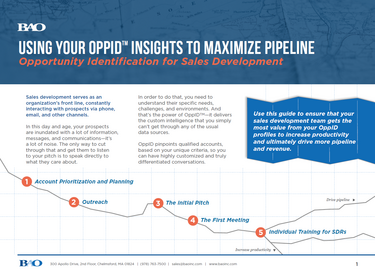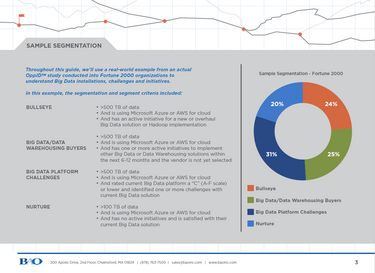Using Your OppID Insights to Maximize Pipeline: Opportunity Identification for Sales Development

Constantly interacting with prospects via phone, email, and other channels.
In this day and age, your prospects are inundated with a lot of information, messages, and communications—it’s a lot of noise. The only way to cut through that and get them to listen to your pitch is to speak directly to what they care about.
In order to do that, you need to understand their specific needs, challenges, and environments. And that’s the power of Opportunity Identification (OppID) —it delivers the custom intelligence that you simply can’t get through any of the usual data sources.
OppID pinpoints qualified accounts, based on your unique criteria, so you can have highly customized and truly differentiated conversations.
Use this guide to ensure that your sales development team gets the most value from your OppID profiles to increase productivity and ultimately drive more pipeline and revenue.
Segments drive action:
Among the many benefits of an OppID project is that every account is segmented, using the information from the profile survey, into one of four (or more) categories based on the criteria you specify. You can work with your BAO team to customize the segments based on your needs.
The following are common categories used to prioritize accounts:
Throughout this guide, we’ll use a real-world example from an actual OppID study conducted into Fortune 2000 organizations to understand Big Data installations, challenges and initiatives. In this example, the segmentation and segment criteria included:
BULLSEYE:
- >500 TB of data
- And is using Microsoft Azure or AWS for cloud
- And has an active initiative for a new or overhaul Big Data solution or Hadoop implementation
BIG DATA/DATA WAREHOUSING BUYERS:
- >500 TB of data
- And is using Microsoft Azure or AWS for cloud
- And has one or more active initiatives to implement other Big Data or Data Warehousing solutions within the next 6-12 months and the vendor is not yet selected
BIG DATA PLATFORM CHALLENGES:
- >500 TB of data
- And is using Microsoft Azure or AWS for cloud
- And rated current Big Data platform a “C” (A-F scale) or lower and identified one or more challenges with current Big Data solution
NURTURE:
- >100 TB of data
- And is using Microsoft Azure or AWS for cloud
- And has no active initiatives and is satisfied with their current Big Data solution

Company: Globalco, Segment: Big Data/Data Warehousing Buyer
| 1. Does your organization use (or plan to use) Hadoop for Big Data? | Yes |
| 2. Which platform do you currently use for your cloud deployment? | AWS |
| 3. How is your organization currently using Big Data solutions and/or management? |
|
| 4. How long has your organization had big data management in place? | > 3 years |
| 5. Which Big Data Platform(s) do you currently have in place? |
|
| 6. How do you grade your current Big Data Platform? |
|
| 7. What types of challenges do you regularly experience with your Big Data platform? |
|
| 8. How large is your organization’s Data Warehousing environment? | 751TB - 1PB |
| 9. What percent of your data is unstructured data? | > 50% |
| 10. What databases and technologies are currently running in your organization’s IT environment? | Database A Database B Database C |
| 11. What types of general data challenges do you regularly experience? |
|
| 12. Which of the following initiatives does your organization have budgeted? Where are you in the implementation/decision making process? | Data warehouse optimization (Discovery /planning) |
| 13. When do you plan to finalize your decision and begin implementation? | 6-12 months |
The profile tells you that Globalco, one of your key prospect accounts, has a lot of unstructured data. They’re currently using two competitive Big Data tools and are challenged with integration, slowness, and getting real-time data. You should use those insights to your advantage.
On your first sales outreach to Globalco, you should lead with your solution’s strength around ecosystem compatibility, performance, and instant data availability. You can come to the call prepared with examples of other customers who were experiencing similar challenges and show how they were able to solve them with your solution. By speaking to what the customer cares about from the get-go, you’ll spark interest and keep them engaged.
If you are already engaged with the prospect, use the information to refine your pitch and drive the conversation to the next step. If you’ve tried unsuccessfully in the past to get into the account, you can similarly use the insights to target an entry point and craft tailored messaging.
Think beyond the contact listed in the profile
Every OppID account profile is gathered via live, phone-based conversations, and includes the contact info for the person who was interviewed by BAO. That’s who we spoke with to get the information, but that may not be the right target from a sales perspective. Find the right title/role/seniority based on your targeting and reach out to those contacts using the account insight from the OppID to tailor the message.
Stick with it
This requires perseverance. You cannot simply leave one voicemail and then move on. It takes an average of 27 dials to deliver one pitch—that is, to get the opportunity to present your solution’s value proposition in order to secure a future appointment. And it takes an average of 130 dials to secure one prospect meeting.
So don’t give up too easily. Since you’ve done your up-front homework, you know these accounts are worth it.
Understand the purpose of the call
When you connect with a prospect, use the specific account insights from the OppID to deliver a short pitch that speaks directly to their specific situation. Remember, in this first call, you’re not selling your product, you’re selling time.
Do not reference the survey
It was performed by a third party and doing so would create confusion and distract from the message you’re trying to convey.
Don't assume it will be an easy pitch
It’s not a warm call just because they’ve been profiled.
Example Pitch, Globalco
Hi, this is <Name> from YourCompany. We help companies using AWS cloud tackle their latency issues and improve overall performance of their big data solutions. We’d like the opportunity to talk with you about how we’ve helped companies like Globalco analyze their unstructured data. I understand you’re currently using Competitor 1 as your big data platform. Many of our customers have found our solution to be superior in providing real-time capabilities. Can we set up a time to learn more about your current challenges, and share some examples of our customers’ successes? **Insights in bold taken from the Globalco account profile above. |
Forego the game of 20 questions
Too often, SDRs have to use the initial meeting to ask a lot of questions. It might seem like this conversation is all about the prospect—after all, you are asking about their needs and technology environment—but in fact it’s all about you, because the prospect gets little value.
The OppID gives you all the information about the account. So instead of asking a lot of questions, you can lead with solutions and focus on providing answers tailored to their situation.
Use those insights to your advantage. Instead of leading with a question, lead with relevant information to help them solve their most pressing challenges. As a result, you’ll transform that first meeting from a one-way discovery session into a truly interactive and engaging discussion.
Create preference for your solution
Use competitive insights from the account profiles to more effectively differentiate your offering right from the start. You’ll know which strengths to focus on—the specific areas where your solution outshines this particular competitive product—to hit home with the prospect without having to call the out competitor by name.
For Globalco first meeting
Our goal is to help your organization get the most value from your OppID profiles.
To do that, the BAO team is happy to conduct an individual training session for your organization. The session will be customized to your OppID segments and include best practices and tactical tips for utilizing your OppID profiles